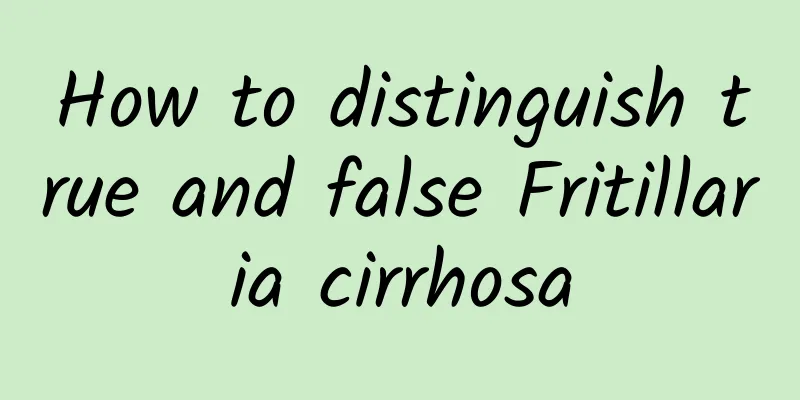How to distinguish true and false Fritillaria cirrhosa

|
Fritillaria cirrhosa is named according to different origins and varieties. Wild Fritillaria cirrhosa is mostly produced in the mountains or bushes in Sichuan Province. When people mention Fritillaria cirrhosa, what comes to mind is its unique effect of relieving cough and reducing phlegm. Recently, many friends have reported that they mistakenly purchased fake Fritillaria cirrhosa when purchasing it. So how do you distinguish between real and fake Fritillaria cirrhosa? The fake Fritillaria cirrhosa looks similar to Fritillaria cirrhosa, but their medicinal properties are both in the form of a whole block without petals. This is an important feature for identifying the authenticity of Sichuan Fritillaria. The medicinal properties of the real Fritillaria cirrhosa The pine shell is conical or nearly spherical, 0.3 to 0.8 cm high and 0.3 to 0.9 cm in diameter. The surface is off-white. The outer scales have two petals of different sizes. The larger petal tightly embraces the smaller petal, and the unembraced part is crescent-shaped, commonly known as "the moon in the arms"; the top is closed. There are cylindrical heart buds with slightly pointed apex and 1 to 2 small scale leaves inside. The tip is obtuse or slightly pointed, the base is flat and slightly concave, with a gray-brown bulb disk in the center and occasional residual fibrous roots. It is hard and brittle, white in cross section and powdery. It has a faint smell and a slightly bitter taste. Fritillaria cirrhosa - Plant morphology: Fritillaria cirrhosa is in the shape of a flat sphere, 0.4 to 1.4 cm high and 0.4 to 1.6 cm in diameter. The outer scales have two lobes, which are similar in size, relatively clasped, and cracked at the top. There are heart buds, 2 to 3 small scale leaves and a thin cylindrical residual stem inside. The furnace shell is long and conical in shape, 0.7 to 2.5 cm high and 0.5 to 2.5 cm in diameter. The surface is off-white (white oven clam) or light brown (yellow oven clam), and some have brown spots. The outer scales have two lobes, which are similar in size, split and slightly pointed at the top, and slightly pointed or blunt at the base. The article has already introduced how to distinguish the real and fake Fritillaria cirrhosa. Although they are very similar in appearance, you can still see the difference if you look carefully. Here we would also like to remind everyone that when purchasing Fritillaria cirrhosa, you should go to a regular pharmacy to ensure that you purchase authentic Fritillaria cirrhosa and avoid being deceived. |
<<: How to distinguish between real and fake wolfberries
>>: What is the medicinal value of Fritillaria thunbergii
Recommend
"Enzyme fighter" appears, PET plastic meets its nemesis
While plastics bring convenience to humans, they ...
The efficacy and function of Zushima
Zushima is a kind of Chinese herbal medicine. We ...
Say goodbye to information asymmetry and restore the true truth about mobile phone repairs!
Some time ago, Ms. Wang from Wuhan repaired her m...
Popular Science | The Birth of Algebraic Topology
The new mathematical objects (matrices, algebras,...
I encountered a lizard three times while on an outing, and it seemed to be the same one?
If you see a small lizard running among the grass...
Once the wound heals, the pain is forgotten, so why do scars remain after the wound heals?
Everyone is familiar with "scar physique&quo...
The efficacy and function of stone chains
There are many kinds of common Chinese herbal med...
What are the herbs for laxatives?
Many people have intestinal discomfort and always...
How to build a habitable planet? An interview with Charles Langmuir
【Author】Xu Yigang 【Translation】Zhao Siyu, Yang Ya...
Flexible ship covers, hatch protection covers... revealing the "black technology" on Tianzhou 6
On the evening of May 10, my country successfully...
"Is there anything that can't be discussed after the New Year?" These things can't be discussed!
The New Year is coming soon, and people often say...
40℃ is not over yet! This summer may be hotter than ever before!
Audit expert: Zhan Mingjin PhD, Chinese Academy o...
Why doesn't New Zealand build a cross-sea bridge between its North and South Islands?
New Zealand is located southeast of Australia, ac...
Side effects of lotus leaf, hawthorn and tangerine peel
The side effects of Heye Hawthorn Fruit Poria coc...
The efficacy and function of golden lotus
In our lives, Nasturtium has attracted our attent...









